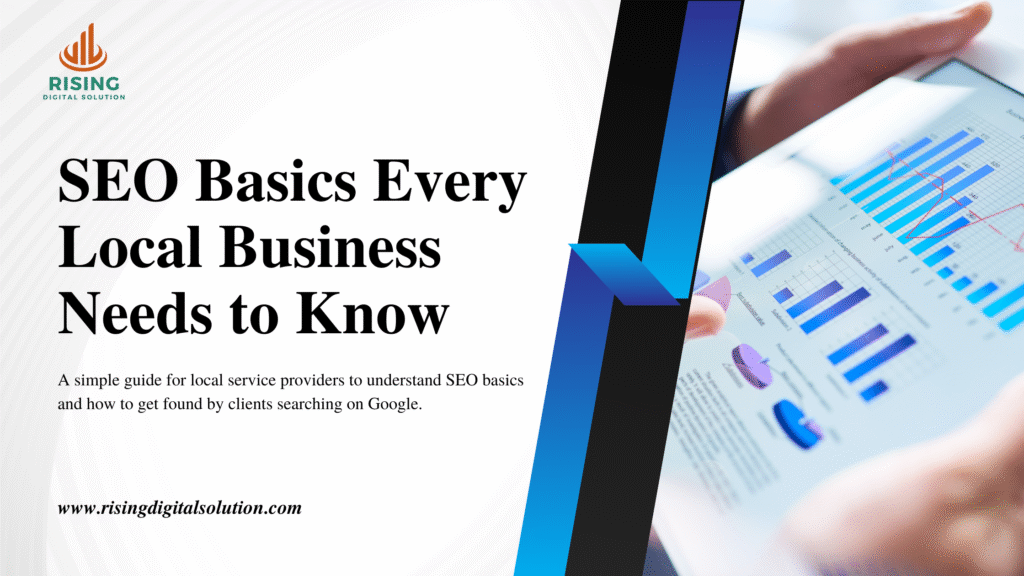In today's digital age, SEO (Search Engine Optimization) is no longer just a nice-to-have. It’s a must-have, especially for local service providers who want to attract more clients and grow their businesses. But don’t worry if SEO feels like a complicated maze. You don’t need to be an expert to start seeing results. In this simple guide, we'll break down the SEO basics that every local business should know and show you how to get found by clients who are searching for services like yours on Google.
Ready to boost your local business's visibility and attract more clients? Get started with our Free Visibility Audit today! Don’t let your competition get ahead — take the first step toward better online visibility and a stronger customer base. Click here to schedule your free audit now and unlock your business’s full potential!
Why SEO Matters for Local Businesses
Let’s start with the basics: SEO is the process of optimizing your website and online presence so that search engines like Google can find and rank you higher in search results. For local businesses, this means making sure you appear when potential clients search for services in your area—whether it’s for plumbing, landscaping, home cleaning, or any other service. Think about it. When someone needs a local service, they’re more likely to search on Google than flip through the phonebook. The higher you rank in local search results, the more likely you are to attract new customers. But how do you get there? Here are the SEO basics every local business needs to know.#1 - Google My Business (GMB) is a Must
Your Google My Business (GMB) listing is the foundation of local SEO. It’s one of the first things that shows up when someone searches for a local service, and it can directly impact your visibility on Google Maps and local search results. How to Optimize Your Google My Business Listing:- Claim and verify your business: If you haven’t done so already, claim your listing and verify it through Google.
- Complete your profile: Fill out every section of your GMB profile, including business name, address, phone number (NAP), hours of operation, and website.
- Add high-quality photos: Include photos of your business, services, and team. This helps make your listing stand out and builds trust.
- Encourage reviews: Reviews are critical for local businesses. The more positive reviews you have, the higher you’ll rank in search results. Don’t forget to respond to reviews, too.
- Post regularly: Use Google Posts to share updates, promotions, and news. This keeps your profile fresh and signals to Google that your business is active.
#2 - Keyword Research for Local SEO
Keywords are the terms people type into Google when they’re searching for a service like yours. For local SEO, the goal is to rank for local keywords—search terms that include your city or neighborhood, such as "plumber in [Your City]" or "best landscaper near me." How to Find Local Keywords:- Use Google’s Keyword Planner: This free tool lets you see how many people are searching for specific keywords in your area.
- Analyze competitors: Check what keywords your competitors are targeting by looking at their website or using tools like Ubersuggest or SEMrush.
- Long-tail keywords: These are longer, more specific phrases, like “emergency plumber in [Your City].” They often have less competition and can attract more qualified leads.
#3 - On-Page SEO: Optimize Your Website
On-page SEO refers to the elements on your website that you can control and optimize to improve your rankings. This includes things like your website’s structure, content, and meta tags. Key On-Page SEO Factors:- Title Tags: The title tag is the headline that appears in search engine results. Include your primary keyword and location in your page title.
- Meta Descriptions: Write compelling descriptions that summarize the content of each page, and include relevant keywords.
- Header Tags: Use H1, H2, and H3 tags to structure your content and include keywords in these headers.
- Content: Create high-quality content that answers your clients’ questions. For example, a plumbing business might write a blog post on “How to Fix a Leaky Faucet” to target informational search queries.
- Internal Linking: Link to other pages or blog posts on your website to help visitors (and search engines) find more of your content.
#4 - Mobile Optimization is Key
More and more people are searching for services on their phones while they’re out and about. If your website isn’t mobile-friendly, you’re missing out on a huge chunk of potential clients. How to Ensure Your Website is Mobile-Friendly:- Responsive design: Your website should automatically adjust to fit any screen size (phone, tablet, desktop).
- Fast loading times: Mobile users expect fast loading times. Use tools like Google PageSpeed Insights to test and improve your site speed.
- Easy navigation: Make sure your contact info, services, and calls to action are easy to find on mobile.
#5 - Build Local Citations and Links
A local citation is any online mention of your business’s name, address, and phone number (NAP). These citations help Google verify your business’s legitimacy and relevance in local search results. Local citations can come from online directories, social media, or local news sites. How to Build Local Citations:- Submit your business to online directories: Include local directories like Yelp, Yellow Pages, Angi, or local Chamber of Commerce websites.
- Get listed in local blogs and websites: If there are local blogs or news sites in your area, ask if you can be featured or listed as a recommended business.
- Build local backlinks: A backlink is when another website links to yours. Local backlinks from reputable sites (like local newspapers or community blogs) can boost your SEO.
#6 - Track Your SEO Results
You can’t improve what you don’t measure. Tracking your SEO performance is essential to understanding what’s working and what needs improvement. Tools to Track SEO Performance:- Google Analytics: Monitor website traffic, conversion rates, and user behavior on your site.
- Google Search Console: See how your site is performing in search results, and identify areas for improvement.
- Rank tracking tools: Tools like SEMrush and Ahrefs can help you track your rankings for local keywords.
Conclusion: SEO is the Key to Local Business Growth
SEO is one of the most powerful tools you can use to increase visibility, attract local clients, and grow your service business. By setting up your Google My Business profile, optimizing your website for local keywords, and building quality citations, you’ll be well on your way to improving your search rankings and generating more leads. The good news is, you don’t need to be an SEO expert to get started. Just take it step by step, and you’ll start seeing results.Ready to boost your local business's visibility and attract more clients? Get started with our Free Visibility Audit today! Don’t let your competition get ahead — take the first step toward better online visibility and a stronger customer base. Click here to schedule your free audit now and unlock your business’s full potential!


